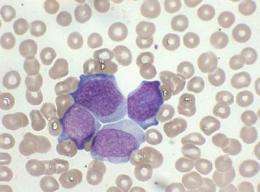Researchers find genetic link to leukemias with an unknown origin

Although leukemia is one of the best studied cancers, the cause of some types is still poorly understood. Now, a newly found mutation in acute myeloid leukemia patients could account for half of the remaining cases of adult acute leukemia with an unknown origin.
"The molecular biology of leukemia has been studied for the last 20 years and we thought we had found most of the common genes for leukemia," comments senior author Craig B. Thompson, MD, director of the Abramson Cancer Center of the University of Pennsylvania. "Now we're able to point to a distinct type of mutation for half of the remaining leukemias for which we didn't know the cause and between one-quarter and one-third of leukemias in older patients." The findings are described online this week in Cancer Cell.
Using samples from a Penn tissue bank of acute myeloid leukemia (AML), Thompson and colleagues found that AML patients have increased levels of a molecule called 2HG. AML is a quick-moving, deadly cancer that starts in the bone marrow and soon moves into the blood. The increased amounts of 2HG stem from a mutation in one of two related metabolic enzymes, IDH1 or IDH2.
Screening for elevations in 2HG in the tissue bank, the team found that IDH1 and IDH2 mutations are observed in over 23 percent of the AML patients studied. A shared feature of cancer-related IDH mutations is increased production of 2HG.
What's more, the IDH gene mutations are the first known cancer mutations that result in the creation of a protein with a new enzymatic activity. Most cancer-causing mutations make the mutated protein either overactive or inactive in performing its normal function. In contrast, the mutations in the IDH proteins give these enzymes the blueprint to create a new molecule not normally produced by cells. Interestingly, the researchers also found that IDH2 mutations are more common than IDH1 mutations in AML.
Other gene-related causes of leukemia include breaks and reformations in chromosomes called translocations.
The ease with which the researchers were able to detect IDH mutations in tumor samples, and the ability to identify patients with these mutations due to the presence of increased 2HG gives hope for better detection of AML and suggests that blocking the production of 2HG might reverse the ability of the mutant genes to maintain the leukemic cells.
"If we're able to block tumors from producing 2HG, perhaps we would be able to stop the patient's leukemia," states Thompson. Exactly why 2HG production leads to leukemia is not yet clear. It does not appear to act like other cancer-causing metabolites which induce further mutations. One possibility raised in the manuscript is that 2HG accumulation may block the ability of the leukemic cells to differentiate into normal blood cells.














